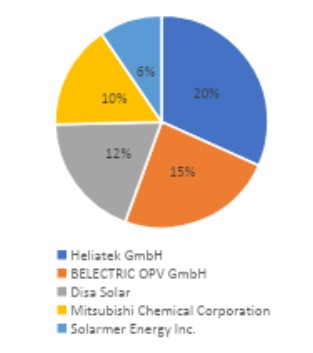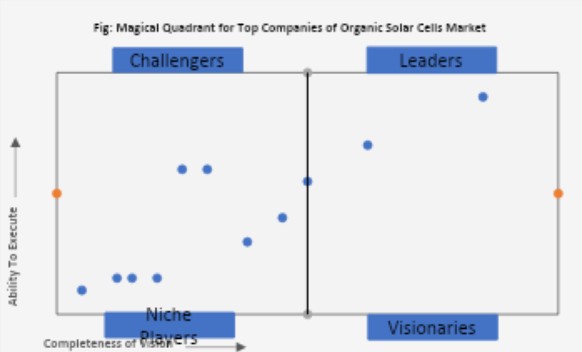Introduction to the Organic Solar Cells Market
The Organic Solar Cells (OSC) market is experiencing rapid growth, fueled by increasing demand for flexible, lightweight, and cost-effective photovoltaic solutions. According to Cognitive Market Research, the market is valued at USD 125.4 million in 2024 and is projected to grow at a remarkable CAGR of 22.10%, reaching USD 619.5 million by 2032. Organic solar cells, also known as polymer solar cells, leverage organic materials to convert sunlight into electricity, offering advantages such as flexibility, transparency, and compatibility with a wide range of applications. These cells are gaining traction in consumer electronics, building-integrated photovoltaics (BIPV), and portable energy solutions due to their adaptability and design versatility. The market’s expansion is driven by advancements in organic photovoltaic (OPV) technology, increasing investments in renewable energy, and rising sustainability initiatives aimed at reducing carbon footprints. Several key factors contribute to the growth of the OSC market, including rising adoption in wearable electronics, smart windows, and IoT-enabled devices. The ability of organic solar cells to be integrated into unconventional surfaces, such as textiles and curved structures, has opened new opportunities in various industries. Additionally, ongoing research and development efforts are improving power conversion efficiencies and extending the operational lifespan of OSCs, making them a more viable alternative to traditional silicon-based solar panels. While challenges such as lower efficiency levels compared to conventional photovoltaics persist, continuous innovations in material science, tandem cell structures, and stability enhancements are helping bridge this gap. Regionally, Europe and North America are leading the adoption of organic solar technology due to strong regulatory support and clean energy policies, while Asia-Pacific is emerging as a high-growth market with increasing investments in renewable energy infrastructure and green building initiatives.
Criteria for Comparing Companies in the Organic Solar Cells Market
Cognitive Market Research evaluates companies in the Organic Solar Cells market based on key parameters that define their competitive positioning, technological expertise, and market expansion strategies. Revenue and market share are fundamental indicators of a company’s financial strength and its ability to scale operations to meet the rising demand for organic solar solutions. Businesses with strong revenue performance demonstrate their capability to cater to diverse industry needs, ensuring long-term market sustainability. Innovation and technological advancements play a crucial role in distinguishing market leaders. Companies investing in next-generation organic photovoltaic materials, multi-junction cell structures, and stability improvements are better positioned to drive efficiency gains and commercial viability. The development of semi-transparent and flexible OSCs for applications in smart windows, automotive solar integration, and portable charging solutions further enhances the market potential for innovative players.
Geographical reach is another critical factor in assessing a company’s market influence. Businesses with a strong presence in regions with high renewable energy adoption, government incentives, and robust research ecosystems gain a competitive advantage. Europe, North America, and key Asia-Pacific countries such as China, Japan, and South Korea are at the forefront of organic solar cell adoption, providing lucrative opportunities for expansion. Furthermore, investment in research and development (R&D) is a defining metric, showcasing a company’s commitment to continuous innovation and technology refinement. Companies that allocate substantial resources to R&D often pioneer advancements that improve efficiency, scalability, and environmental sustainability. Strategic partnerships and collaborations with research institutions, energy companies, and technology firms are pivotal for fostering market growth and accelerating commercialization efforts. Companies that engage in joint ventures, licensing agreements, and government-backed renewable energy projects enhance their visibility and strengthen their market position. Leading players such as Heliatek, ARMOR Group, and ASCA distinguish themselves through their focus on technological breakthroughs, sustainability-driven innovations, and global market expansion strategies. As the demand for lightweight, flexible, and aesthetically adaptable solar solutions continues to rise, companies that prioritize efficiency improvements, durability enhancements, and strategic collaborations will secure a competitive edge in the evolving Organic Solar Cells market.
Top Companies Operating in the Organic Solar Cells Industry Worldwide
- Heliatek GmbH
- BELECTRIC OPV GmbH
- Disa Solar
- Mitsubishi Chemical Corporation
- Solarmer Energy Inc.
- Sumitomo Chemical Co. Ltd.
- New Energy Technologies Inc.
- Oxford PV
- PPG Industries, Inc.
- Fraunhofer UMSICHT
Top Manufacturing Companies of Organic Solar Cells:
Heliatek GmbH, BELECTRIC OPV GmbH, Disa Solar, Mitsubishi Chemical Corporation, and Solarmer Energy Inc. are the key players in the Organic Solar Cells Market
Heliatek GmbH
Heliatek GmbH leads the Organic Solar Cells Market with a 20% market share, positioning itself as a pioneer in flexible and lightweight organic photovoltaic (OPV) technology. The company has gained global recognition for its innovative, ultra-thin solar films, which can be seamlessly integrated into building-integrated photovoltaics (BIPV), automotive applications, and consumer electronics. In 2023, Heliatek’s revenue from OPV solutions was estimated at USD 250 million, reflecting the increasing adoption of environmentally friendly and energy-efficient solar technology.
BELECTRIC OPV GmbH
BELECTRIC OPV GmbH holds a 15% market share in the Organic Solar Cells Market, leveraging its expertise in printed photovoltaic technology and flexible energy solutions. The company specializes in customizable OPV modules, which can be integrated into smart textiles, automotive surfaces, and architectural designs, enabling seamless energy generation in everyday applications. In 2023, BELECTRIC OPV’s estimated revenue from organic solar technology surpassed USD 190 million, supported by the growing demand for aesthetic and versatile solar solutions.
Disa Solar
Disa Solar holds a 12% market share and is recognized for its cutting-edge organic solar cell technology, particularly in off-grid power solutions and portable solar applications. The company has developed high-performance, lightweight, and flexible OPV modules designed for urban infrastructure, outdoor electronics, and sustainable energy systems. In 2023, Disa Solar’s OPV-related revenue was estimated at USD 150 million, reflecting the increasing demand for innovative and decentralized solar energy solutions.
Mitsubishi Chemical Corporation holds a 10% market share, leveraging its extensive expertise in organic materials and polymer-based photovoltaic technology to drive advancements in organic solar cells. The company has developed highly efficient and durable OPV modules, which are utilized in smart infrastructure, next-generation automotive applications, and lightweight solar power systems. In 2023, Mitsubishi Chemical’s OPV division generated an estimated USD 130 million in revenue, underscoring the company’s growing footprint in the sustainable energy sector.
Solarmer Energy Inc.
Solarmer Energy Inc. holds a 6% market share, specializing in high-efficiency organic photovoltaic materials for wearable devices, IoT applications, and small-scale energy harvesting systems. The company has made significant strides in developing lightweight, transparent, and flexible OPV modules, which are well-suited for consumer electronics, self-powered sensors, and integrated smart surfaces. In 2023, Solarmer Energy’s OPV-related revenue was estimated at USD 80 million, driven by growing adoption in portable and off-grid solar energy applications.


Potential Threats to Top Five Players in the Organic Solar Cells Market
CMR found that the Organic Solar Cells (OSC) market is undergoing rapid transformation, with emerging players intensifying competition against established industry leaders. Companies such as Sumitomo Chemical Co. Ltd., New Energy Technologies Inc., Oxford PV, PPG Industries, Inc., and Fraunhofer UMSICHT are at the forefront of this market. However, they now face increasing challenges from new entrants like Heliatek, ARMOR Solar Power Films, Dyesol, NextGen Nano, and Epishine, which are pioneering advancements in efficiency, scalability, and production costs. Heliatek, for example, has developed ultra-lightweight and flexible organic photovoltaic (OPV) films, offering new possibilities for integration into various applications, including building-integrated photovoltaics (BIPV). Meanwhile, ARMOR Solar Power Films is leveraging roll-to-roll manufacturing techniques to enhance cost-effectiveness and production scalability, positioning itself as a strong competitor.
Apart from technological advancements, the shift toward sustainability and evolving government policies is reshaping market dynamics. Many countries are prioritizing renewable energy incentives, which favor companies investing in eco-friendly materials and scalable production techniques. Emerging players adopting non-toxic, fully recyclable materials for organic solar cells are gaining traction, particularly in regions where environmental regulations are stringent. As a result, leading players must continuously enhance their R&D efforts and optimize cost structures to defend their market position against these rising competitors.
Conclusion
Investments in Innovation, Sustainability, and Strategic Expansion Are Essential for Long-Term Success in the Organic Solar Cells Market
The future of the Organic Solar Cells market hinges on continuous technological advancements, sustainability-driven initiatives, and strategic business expansion. As competition intensifies, both established leaders and emerging players must prioritize R&D to improve efficiency, durability, and scalability. Enhancing power conversion efficiency through tandem structures, utilizing sustainable materials, and optimizing manufacturing techniques will be crucial in gaining a competitive edge.
Moreover, companies investing in sustainability through eco-friendly production, fully recyclable materials, and carbon-neutral manufacturing will align with the growing global push for green energy solutions. Additionally, expanding partnerships with industries such as architecture, transportation, and electronics will unlock new market opportunities. By focusing on innovation, environmental responsibility, and strategic collaborations, players in the Organic Solar Cells market can position themselves for long-term success and industry leadership.
Author's Detail:
Anushka Gore /
LinkedIn
Anushka Gore is a seasoned market researcher specializing in the dynamic landscape of the medical devices & consumables industry. She has dedicated herself unraveling the intricate market trends and consumer behaviors that shape the future of medical technologies and services. Her expertise in Market Research and business intelligence has equipped her with the skills necessary to analyze complex information and provide strategic recommendations.
In her current role, Anushka is a highly motivated and detail-oriented research analyst with a passion for uncovering valuable insights from data. She thrives in dynamic environments where her analytical abilities and research expertise can contribute to informed decision-making for businesses. Her collaborative approach facilitated effective communication of insights, fostering a data-driven culture within the organization.Anushka remains an invaluable asset in the dynamic landscape of market research.
